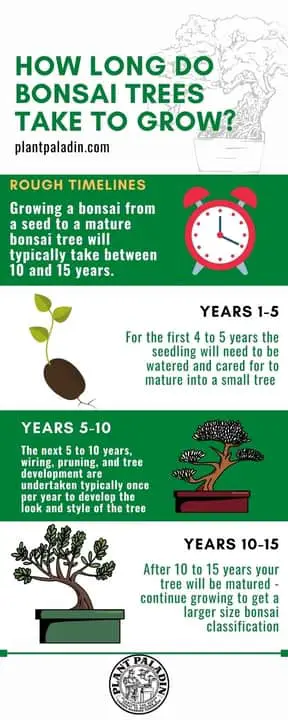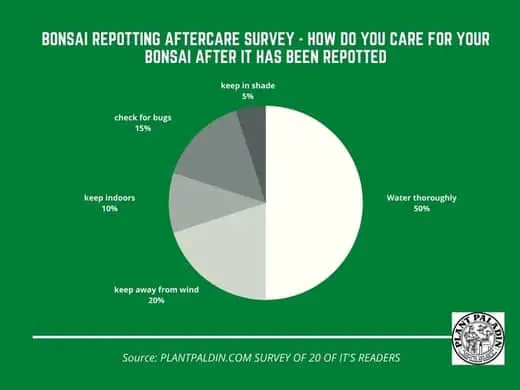This website is supported by its readers. If you click one of my links I may earn a commission. I am also a participant in the Amazon affiliates program and I will also earn a commission from qualified purchases.

Like a lot of you reading this, when I first started my bonsai journey I failed to understand some of the major challenges that are associated with growing bonsai trees. One obstacle I faced was just how long it took to grow out a decent-looking bonsai tree. So how long do bonsai trees take to grow?
Bonsai trees, regardless of size or species on average take between 10 to 15 years to reach maturity, if grown from scratch. Fast-growing species of bonsai such as Chinese Elm can reach maturity within 10 years, with slower-growing species such as Jade taking up to 15 years.
So what can you do to speed up the bonsai tree growing process, and exactly how long can bonsai trees live? Keep reading to find out more!
Just a quick heads up, over the past three years of running Plantpaladin, hundreds of people have asked for product recommendations. As such, You can find my favorite indoor bonsai tree here (link takes you to Bonsaiboy), my favorite outdoor bonsai tree (link takes you to Bonsaiboy), or have a look at all the products I recommend here.
How long do bonsai trees take to grow?
One of the things I love the most about bonsai is the life lessons it brings to you.
Patience, patience and you guessed it more patience are required to successfully grow a tree.
Whilst most bonsai owners know that growing bonsai trees is typically a lifelong hobby, what are the exact timescales you should be looking for before you embark on a new bonsai journey.
As such, I used my own experience growing out trees over the past few years, spoke with a few bonsai experts, visited my local botanical garden, and even did a quick survey of plant paladin readers to get a good idea of how long bonsai trees take to grow.
Here is what I found
How long do bonsai trees take to grow? – Quick facts
- Growing a bonsai from a seed to a mature bonsai tree will typically take between 10 and 15 years.
- For the first 4 to 5 years the seedling will need to be watered and cared for to mature into a small tree before any form of wiring, trunk development or pruning can take place.
- For the next 5 to 10 years, wiring, pruning, and tree development are undertaken typically once per year to develop the look and style of the tree.
- After 10 to 15 years the seedling will have matured into a small one or two-handed bonsai tree.
- Now whilst the tree will be matured after 10 to 15 years, should you want your tree to be large such as the Hachi-uye or imperial bonsai size classification sizes, many more years of growing your tree and pruning will need to be done.
- This is one of the reasons why bonsai trees that are over 30 years old are usually well over one meter.
- Bonsai tree species grow at different rates with certain species maturing at 10 years with others maturing at 15 years.
- Most bonsai trees will grow between 2 and 36 inches during the growing season.
- Chinese elm bonsai will typically reach maturity in about 10 years.
- Juniper bonsai will reach maturity at about 12 years.
- Jade bonsai will reach maturity in 15 years.
Bonsai tree timeline explained
So now we know that growing a bonsai tree from a seedling can take about 10-15 years. I thought it would be worth going into the exact details of what the different growing stages look like in more detail.
If you are in a rush however I’ve created a table below which should help summarize those different timelines nicely:
| Bonsai tree stage | Number of years: Slow growing trees | Number of years: Fast-growing trees |
| Planting stage | Years 1-5 | Years 1-3 |
| Style stage | Years 5-10 | Years 3-7 |
| Pruning and growth stage | Years 10 – 15 | Years 7-10 |
| Aftercare stage | Years 15+ | Years 10+ |
Planting stage – Years 1-5
So the first stage of growing a bonsai tree and arguably the most important stage in the life of any bonsai tree is the planting stage.
Seeds do not have a 100% germination rate and so extra care needs to be given when planting your seeds.
In this stage, a seed, seedling, or cutting is planted in potting soil – typically with root hormone to help the tree propagate.
The seed is then watered, given enough sunlight, and even kept in a propagator to maintain the correct temperature level for optimal growth
After a few weeks, the seedlings or cuttings will start to sprout new healthy roots and can then be moved into the shade outdoors and then gradually in the sunlight.
A common mistake at this stage is to start the pruning process, as soon as the bonsai has some size on it, but it is best to see your bonsai tree as a baby at this stage and avoid any pruning.
It’s important then to keep an eye out for any bugs or pests that might want to attach to your tree.
At this stage, all you want to worry about is growing your tree which you can do with the growth of sacrificial branches.
Do not touch or prune your bonsai at this stage for 3 to 5 years, letting your tree just do its things and grow out.
Style stage – Years 5-10

So once you have grown your bonsai tree from a seedling for a few years, your tree will be strong enough to start pruning and training into the style of bonsai tree you want.
Now bonsai trees come in a wide variety of styles such as informal upright, cascade, sem-cascade, and sumo – so it’s important to have somewhat of an understanding and design idea at this stage of how you would like your tree to look.
During the next 5 to 10 years you will be doing the following activities to help shape your bonsai into the style of bonsai you would like:
- Developing the thickness of the trunk
- Developing the shape and movement of the trunk
- Adding a general taper to the trunk of your bonsai
- Wiring the branches of your tree to maneuver and train the branches to look a certain way
- Repotting the tree
- Pruning and defoliating the leaves of your tree to make a more visually pleasing tree and to add depth to the leaf canopy.
Now each of these will take a few months to a few years to complete depending on the complexity of the style of bonsai you have decided to go for.
To make things even more complicated, bonsai trees cannot be worked on year-round, instead opting to be worked on during the early spring through the summer.
This means for about 5 to 6 months of the year you will be unable to train your tree as you winterize it.
Pruning and growth stage – Years 10-15
The next 5 or so years of growing your bonsai tree will be a lot of the same as the previous steps as the tree enters maturity.
At this stage, especially in fast-growing trees, it is very important to keep an eye on things like the root structure of your tree.
Avoid planting your bonsai tree at this stage into the ground as all the hard work you will have undertaken to turn your seedling into a bonsai will become undone should the roots hit normal soil at this stage.
Regularly repot your bonsai into bigger pots with more drainage holes and continue working regularly or maintaining the size of your bonsai tree at this stage.
Should you want your bonsai tree to be a tiny finger-tip size bonsai then at this stage you want to ensure you prune and trim the branches regularly so the tree does not become too big.
Aftercare stage – 15 years +
So at this stage, your bonsai tree will have fully matured and so the next few years are all about regular aftercare.
Ensuring you continue to repot your tree regularly, upgrade its potting soil and just keep an eye out for pest or fungal infections.
Unless you have pruned or trimmed the branches and leaves of your bonsai in the previous step most of you will likely not have either a one-hand or two-hand sized bonsai at this stage.
If however, you would like to continue to grow out your bonsai tree to become larger and larger (aiming for something like an imperial-sized bonsai and then you will need to continue growing your tree out in cycles.
I would recommend growing your tree out completely for a year or so at this point and then trimming back and retaining the tree.
You won’t have to worry about your tree becoming a regular tree again because after 10 to 15 years it will have matured into a bonsai.
How long do bonsai trees take to grow? – Size classifications
So now we know that most bonsai trees take about 15 years to grow a one to two-hand sized bonsai, what about the other bonsai sizes?
After all bonsai trees, especially those bonsai trees that you see in competitions are usually broken down into different size classifications.
Luckily to help put this in perspective I’ve made a table below:
| Classification | Size inches | Size Centimeters | Hand size | Years to grow | General size |
| Keshitsubo | 1 to 3 inches | 3 to 8 centimeters | Fingertip | 3 to 5 | Tiny |
| Shito | 2 to 4 inches | 5 to 10 centimeters | One-hand | 5 to 7 | Tiny |
| Mame | 2 to 6 inches | 5 to 15 centimeters | One-hand | 5 to 7 | Small |
| Chohin | 5 to 8 inches | 13 to 20 centimeters | One-hand | 7 to 10 | Small |
| Kumono | 6 to 10 inches | 15 to 25 centimeters | One-hand | 7 to 10 | Small |
| Katade-mochi | 10 to 18 inches | 25 to 46 centimeters | Two-hand | 10 to 12 | Medium |
| Chiu or Chumono | 16 to 36 inches | 41 to 91 centimeters | Two-hand | 12 to 15 | Medium |
| Dai or Omono | 30 to 48 inches | 76 to 122 centimeters | Four-hand | 15 to 20 | Large |
| Hachi-uye | 40 to 60 inches | 102 to 152 centimeters | Six-hand | 20 to 25 | Large |
| Imperial | 60 to 80 inches | 152 to 203 centimeters | Eight-hand | 25 to 35 | Large |
Now if you are a little confused about the actual size classification of bonsai I would recommend having a look at my bonsai size classification post here or checking out the following:
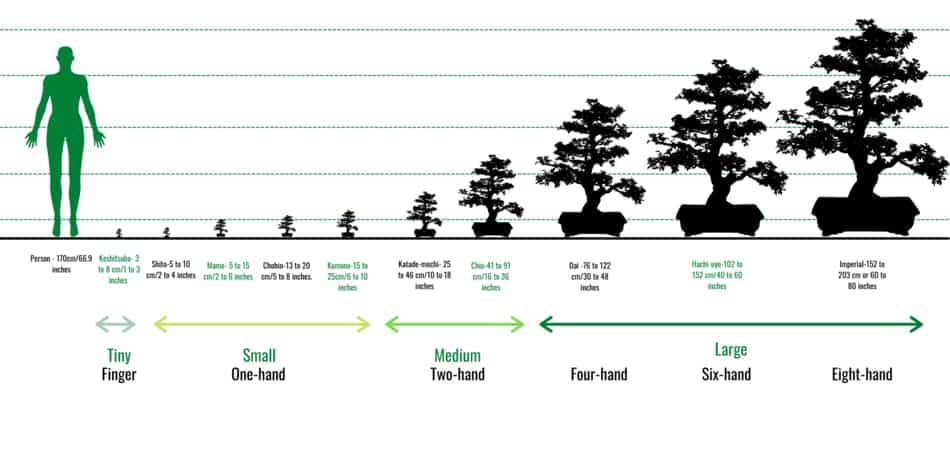
How long does Keshitsubo fingertip bonsai take to grow?
Keshitsubo fingertip bonsai on average takes between 3 to 5 years to reach maturity. This is because this bonsai is tiny in size, meaning the amount of time it will take to create a thick trunk and branch structure for the size of the tree will be much less than other size classifications.
How long does Shito one-hand bonsai take to grow?
A shito bonsai, also commonly known as a small one-hand bonsai, will typically take between 5 to 7 years to grow. Shito bonsai will spend the first 3 years to reach maturity and then a further 2 years to design and train.
How long does a Mame one-hand bonsai take to grow?
One-hand mame-sized bonsai will take between 5 to 7 years to grow. The first 3 to 5 years will be used to grow, thicken and mature the tree. The remaining 2 years will be required to train and style the tree.
“Mame and one-handed bonsai, in general, are the most common bonsai available on the market.”
How long does a chohin one-hand bonsai take to grow?
Chohin bonsai, which are classified as being between 5-8 inches will typically take between 7 to 10 years to grow. The first 4 to 5 years of Chohin bonsai will be spent growing and maturing the tree. The remaining years are spent styling and training the tree to a specific bonsai tree style.
How long does a Kumono one-hand bonsai take to grow?
Kumono one-hand bonsai will take 7 to 8 years to grow. Kumono bonsai when mature, will reach between 6 to 10 inches making them amongst the most popular size classifications of bonsai. The first 4 years will be spent maturing the tree with the remainder used for styling.
How long does a Katade-mochi two-hand bonsai take to grow?
Two-hand Katade-mochi bonsai takes between 10 and 12 years to grow from seed. The first 5 years are spent maturing the tree for bonsai. Then the remaining 5 to 7 years are spent growing the tree to 10-18 inches in a specific style.
How long does a Chiu or Chumono two-hand bonsai take to grow?
Chiu or Chumono bonsai, commonly referred to as two-hand bonsai, take on average 12 to 15 years to reach their size of between 16 to 36 inches. The larger the size, the longer the tree will take to grow. After 5 years, Chiu or Chumono bonsai can be styled and pruned.
How long does a four-hand Dai or Omono bonsai take to grow?
Four-hand Dai or Omono bonsai will take between 15 and 20 years to grow to the 38 to 40 inches the size classification requires. The first 5 years will be spent maturing the tree with the remaining years spent maturing and styling the tree.
How long does a six-hand Hachi-uye bonsai take to grow?
A six-hand Hachi-uye bonsai will take between 20-25 years to grow. The first five years are spent maturing the tree with the remaining years spent growing the tree to the 40 to 60 inches the tree requires.
How long does an eight-hand imperial bonsai take to grow?
Imperial bonsai take 25 to 35 years to grow into 60 to 80 inches in size. Commonly known as eight hand bonsai, imperial is growing the largest bonsai tree species out there and so will commonly take the longest time to grow. Bonsai trees larger than this size classification will often take more than one lifetime to grow.
How long do bonsai tree species take to grow?
So now you know how long bonsai trees take to grow into varying size classification, what about bonsai tree species.
After all, bonsai trees are made up of several different types of species ranging from indoor Chinese Elms to outdoor Junipers.
To help summarize I’ve created a table below which highlights the most common, best-selling bonsai tree species, how much they grow per year, and roughly how long it will take for these trees to reach maturity.
Just keep in mind that maturity does not necessarily mean a finished bonsai tree, just that it will be ready to adapt and start training to achieve the bonsai tree style or size classification you want:
| Bonsai species | Growth type | Time to maturity | Average growth per year |
| Chinese Elm | Fast | 3 years | 12 to 36 inches |
| Juniper | Moderate | 4 years | 5 to 12 inches |
| Jade | Slow | 5 years | 2 to 5 inches |
| Maple | Fast | 3 years | 12 to 36 inches |
| Fukien Tea | Slow | 5 years | 2 to 5 inches |
| Ficus | Fast | 3 years | 12 to 36 inches |
| Wisteria | Slow | 5 years | 2 to 5 inches |
| Cotoneaster | Moderate | 4 years | 5 to 12 inches |
| Pine (most varieties) | Fast | 3 years | 12 to 36 inches |
| Azalea | Slow | 5 years | 2 to 5 inches |
Let’s explore these in more detail:
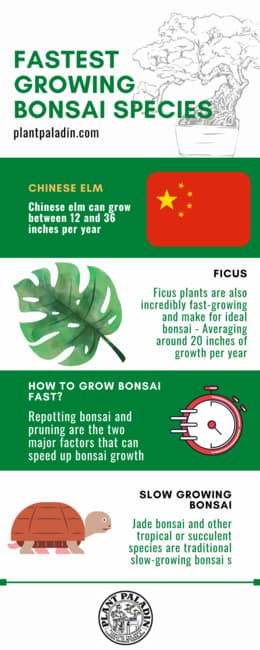
How long do Chinese elm bonsai take to grow?
Chinese elm bonsai is a fast-growing plant species and should reach maturity within 3 years. As such, Chinese elm bonsai is one of the most popular bonsai species on the market, averaging 12 to 36 inches of growth during the summer growing season.
How long do Juniper bonsai take to grow?
Juniper bonsai take 4 years to grow into maturity if growing from seed or cutting. Juniper is a moderate growing species averaging 5 to 12 inches of growth per year.
How long does Jade bonsai take to grow?
Jade bonsai is a slow-growing species of tree and can take 5 years to grow from a seedling into maturity. Jade bonsai average between 2 and 5 inches of growth per year. This slow growth makes them ideal for indoor bonsai keeping.
How long do Maple bonsai take to grow?
Maple bonsai trees grow fast and will reach maturity from ba selling in 3 years. Maples will average between 12 to 36 inches of growth per year and this fast growth makes them ideal for being kept outdoors.
How long do Fukien-tea bonsai take to grow?
Fukien tea bonsai is a slow-growing tree species and will take 5 years to grow and reach maturity from a seedling. Fukien tea will only grow between 2 and 5 inches per year during the summer growing season.
How long does Ficus bonsai take to grow?
Ficus bonsai take 3 years to grow and reach maturity when planted from a seedling or a cutting. These trees are ideal for bonsai due to their fast growth, averaging between 12 and 36 inches of growth per year.
How long do pine bonsai take to grow?
Coniferous Pine bonsai species such as White Pine or Scots Pine take 3 years to grow when grown from a seedling or cutting. All pines are very fast growing averaging between 12 and 36 inches of growth each year.
How much does a bonsai tree grow in one year?
Bonsai trees will typically grow between 2 and 36 inches per year depending on the species. Slower growing species such as Azaleas add 2 to 5 inches of size during the summer growing season. Faster growing bonsai such as Maple or Elm can grow as much as 36 inches per year.
How can I speed up my bonsai tree?
A lot of you reading this post will be doing so as you look for ways to speed up bonsai tree growth. Luckily there are a few quick things you can do to speed up the drudgery of growing out a bonsai.
These include:
- Choosing a fast-growing species
- Buying a store-bought tree
- Planting your tree in the ground
- Thin out your roots
- Repot your tree regularly
- Maintain your tree regularly
- Aim for trunk growth
Let’s explore these in more detail
Choose a fast-growing species
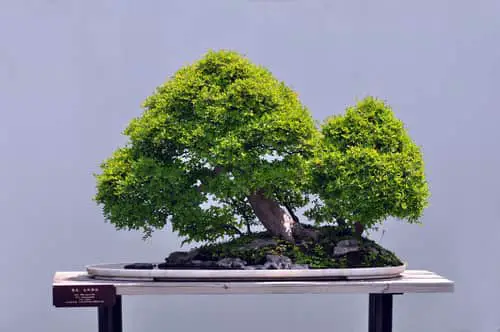
If you have not purchased your tree yet, then the best thing you can do is opt for a bonsai tree species that is fast growing.
We talked about this earlier on, but not all bonsai tree species are created equal with bonsai tree species such as pines, elms, maples, and oaks all being very fast-growing species – growing between 12 to 36 inches in size every year.
I would avoid slower growing species such as Jade, Wisteria, or Fuckin Tea species that can add as little as 2 to 5 inches per year and also take five years to reach maturity if planting from scratch.
Buying a store-bought tree
Similar to the point above, if you have not yet purchased your bonsai or bonsai seeds then I would recommend buying a store-bought or pre-owned bonsai tree.
These trees will typically already be at least the size of a one-hand bonsai and will have gone through the maturation phase.
This will also prevent you from having to manage the process of growing your bonsai tree from scratch, saving you the first 3 to 5 years in your bonsai tree’s development.
Most bonsai tree retailers will sell trees that are between 3 to 5 years for a relatively inexpensive price.
If you would like a larger older bonsai tree then these too can be bought from reputable retailers – so long as you have the money to pay for them.
Planting your tree in the ground
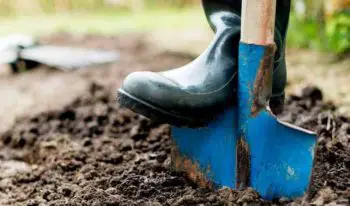
If you already have a bonsai tree – fret not, there are still a few things you can do to speed up the process of growing your bonsai.
One of the best methods to speed up the process of the root, trunk, and bonsai tree growth is simply by planting your bonsai in the ground.
Bonsai trees are restricted in the pots we keep them in and are limited to the nutrients in the potting soil we have.
Planting your bonsai in the ground will not restrict the number of valuable chemicals found in natural soil massively increasing the growth of the tree.
Just ensure that you do this process once the tree has been mature in its first 3 to 5 years and you have to worry about your bonsai just turning into a regular-sized tree.
Thin out your roots
Trust me when I first heard this one I was a little confused too – surely removing some of the roots in my bonsai tree is going to impede its ability to grow faster right?
As the majority of us will be keeping our bonsai trees in pots, the roots of our trees will continue to grow and thicken as they search for nutrients and water that is often not found in shallow bonsai tree pots.
As these roots grow, they start to impede the other roots and the soil structure of the post your bonsai is kept in.
This can lead to your roots drying out and generally affecting the health of your tree.
As such, it’s important to regularly prune the roots of your bonsai tree.
This will typically be done once per year for most plants – I like to do this usually during the repotting process.
If however, you do have a super fast-growing tree, its roots too will also
Having thinner shorter roots in your bonsai will allow for a healthy tree which will further maximize the growth of your bonsai tree.
Repot your tree regularly
Similar to the point above it is essential that you repot your bonsai ree regularly.
Most bonsai trees will outgrow the existing bonsai pots and so will need to be repotted at least once every 2 years for most tree species.
Bonsai trees require more soil, more drainage holes, and more pruning as you grow them which is why repotting is essential to meet these needs.
Failing to repot your trees will result in stunted tree growth which is ideal for growing smaller bonsai such as fingertip bonsai, but not ideal for other bonsai tree sizes.
Remember to also trim the roots of your bonsai when you repot as this will make the process easier.
Repotting bonsai is a task all onto itself so I would recommend you check out the following posts:
Maintain your tree regularly
A lot of the time, the reason why our bonsai trees are just not growing is that we are just not doing the day-to-day work that our trees require.
Ensuring then that you:
- Fertilize your bonsai tree once per month during the spring/summer.
- Water your bonsai tree regularly – touching the topsail to make. sure it is dry so you do not under or overwater your tree.
- Give your bonsai tree plenty of sunlight.
- Prune the leaves of your tree to ensure an even distribution of light for your trees.
- Maintain the correct temperature of your tree.
- Winterize your tree if need be.
And you will find that you will have no issues with your bonsai tree growth.
Aim for trunk growth
One often neglected part of growing a bonsai tree faster is forgetting all about the trunk of the bonsai.
Whilst the roots of your tree absorb the nutrients and water from the soil, it is your trunk’s responsibility to pass this to the leaves and branches of your tree.
As such, growing out a thick bonsai trunk will ensure you have a fast-growing thick tree. _ thick trunks also work well for things like bonsai tree driftwood for aquarium.
Now from an aesthetic standpoint, the trunk of a bonsai can be manipulated in looking bigger for aesthetic purposes.
This can often be done by:
- Splitting the trunk of your bonsai
- Merging bonsai trunks
- Trunk chopping your bonsai to add taper
All these methods are quite complex however so I would recommend reading up on my respective blog posts for each of them.
Just keep in mind that this will be purely from a visual standpoint of having a thicker bonsai trunk as opposed to growing out the entire tree.
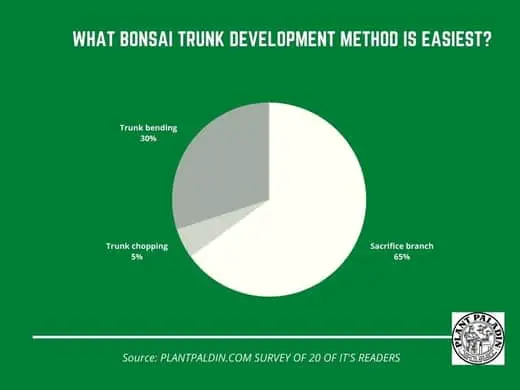
FAQ’s on how long bonsai trees take to grow
So hopefully you now understand how long bonsai trees take to grow and all the different growth rates for different bonsai tree styles and species.
That being said I’m sure some of you will likely still have some questions about how long bonsai trees take to grow.
Hopefully, the questions below then will help:
Why do bonsai trees take so long to grow?
Bonsai trees take so long to grow because of the amount of care, patience, and training bonsai trees require. Even the most basic of bonsai tree styles such as formal upright, take years to train and manipulate into an esthetically pleasing tree through wiring, pruning, and trunk development.
How does seasonality affect bonsai tree growth?
Most bonsai trees do not grow in the winter and start to shut down during the fall. Even coniferous evergreen bonsai such as pine or jumper species do not grow as fast in the colder months. As such, most bonsai trees will only grow for 6 months per year – from early spring to late summer.
How long can bonsai trees live?
The oldest recorded bonsai tree is over 1000 years old. Most bonsai trees can live for 100 years if regularly cared for and maintained correctly. Some bonsai hobbyists have passed their bonsai down through the generations and have trees that are hundreds of years old.
To read up more on this check out my post on how long bonsai trees live.
How to find the age of a bonsai tree?
Multiply the diameter of your bonsai tree by its growth rate to determine the general age of your bonsai tree. For more accurate measurements, remove a large branch or slice the trunk of your tree and count the number of rings.
To read up more – check out my post on bonsai tree age here.
How long does it take for a mini bonsai to grow?
Mini fingertip bonsai – better known as Keshitsubo bonsai will typically take 3 years to grow into maturity if a fast-growing bonsai species such as maple is used, and 5 years if a slow-growing plant species such as Jade is used.
Does bonsai tree size affect bonsai tree growth?
Bonsai tree size and bonsai tree growth are not the same things. Tree size is the size classification a bonsai tree falls under, for example, a one-hand bonsai tree, a two-hand bonsai tree, a four-hand bonsai tree.
Bonsai tree growth is the rate at which a bonsai tree grows – for example, a Chinese elm bonsai will typically grow between 12 and 36 inches per year.
Once a bonsai tree hits a certain bonsai tree size classification you are happy with – such as the two hand bonsai tree size classification, regular pruning and maintenance will need to be undertaken to ensure the remains that size.
Benefits of how long it takes bonsai trees to grow?
The main benefit of having a bonsai tree that takes a long to grow is that these trees usually sell for more money. Bonsai trees that are 100 years old for example usually sell for a lot more than trees that are 20 or 30 years old.
How long do bonsai trees take to grow? – study
Finally, I wanted to finish up by citing some evidence for the information in the post today.
First, I visited my local botanical gardens and asked them how long their trees take to grow in their collection:
“ The trees in our collection matured a long time ago with some of our bonsai being over 100 years old. Most bonsai trees after 4 to 5 years of planting will be able to be molded into a bonsai tree”
I also did a quick survey of 20 plant paladin readers, asking them their thoughts on how long do bonsai trees take to grow – here were the results:

My top picks for the gear you will need!
So like I mentioned earlier, over the past three years of running PlantPaladin, hundreds of people have asked me for my recommendations on the best bonsai gear on the market.
Having spent thousands of dollars on bonsai items these past few years and tested at least 100 bonsai-specific products, I’ve listed my favorite products below – All of which I highly recommend and think you can get great value.
They can purchase directly by clicking the link to take them to Amazon.
Bonsai Tool Set: One of the significant challenges I’ve had is finding a toolset that was not only durable but didn’t break the bank. SOLIGT has recently developed a fantastic bonsai tool set that covers all the tools you need to trim, prune, and repot your trees. – You can grab it here.
Complete Bonsai Set: Many of you will want to grow your bonsai trees entirely from scratch, but finding the varicose seeds, pots, and other items in one place can be challenging. Leaves and Sole then have created a complete bonsai set that I’ve personally used that ticks all the boxes. You can grab it here.
Bonsai wire: The number of times I’ve run out of wire for my bonsai or purchased cheap bonsai wire that doesn’t do the job is embarrassing for me to admit. After a lot of trial and error, I found that using Hotop’s aluminum bonsai wire is one of the best options on the market. This can easily be used for both indoor and outdoor bonsai. You can grab it here.
This post was written by Fehed Nicass who has been passionate about bonsai for over 3 years.

